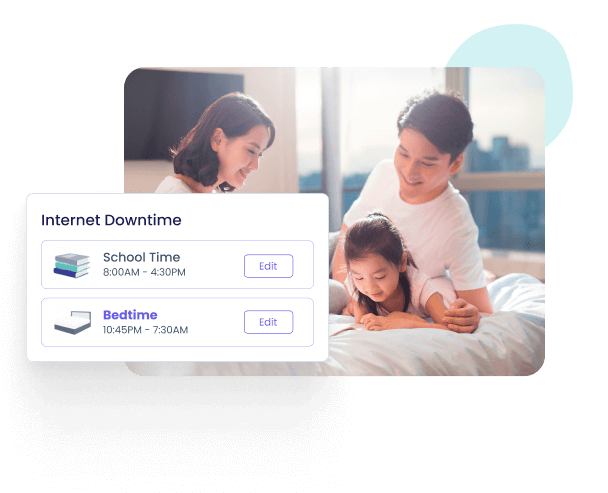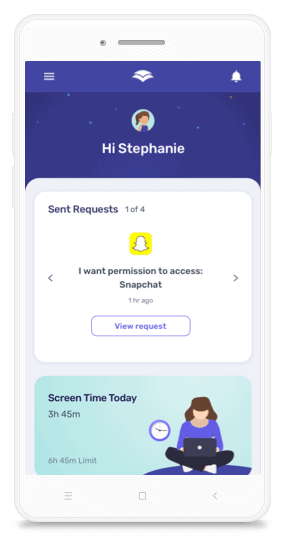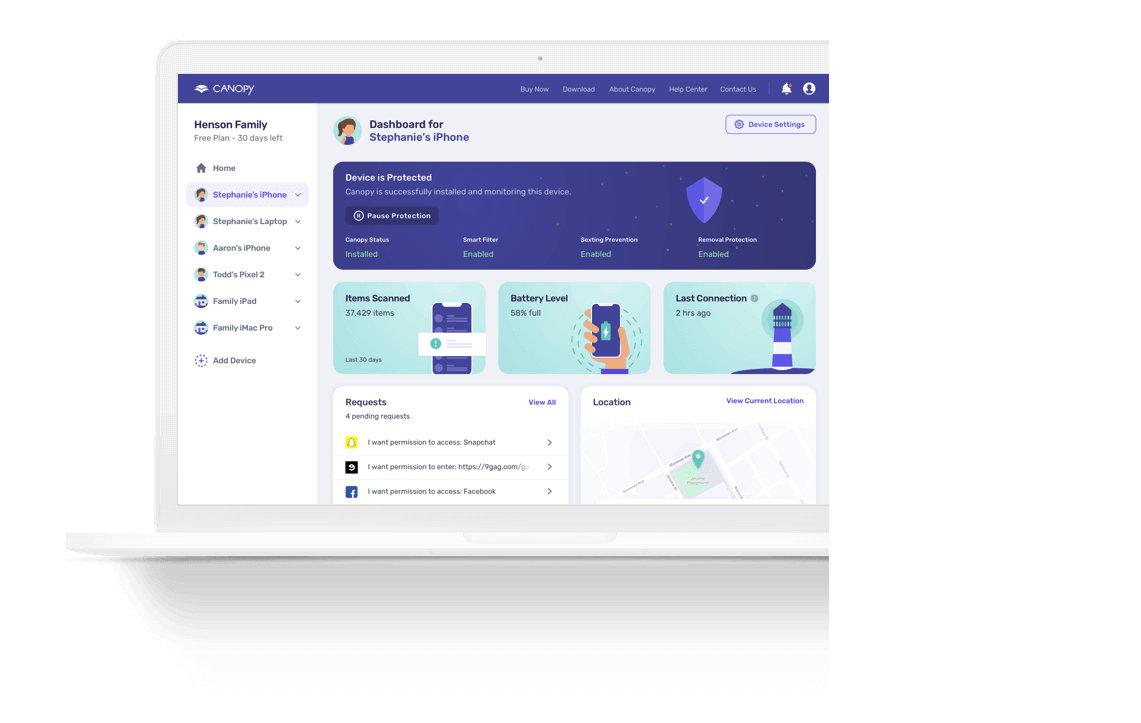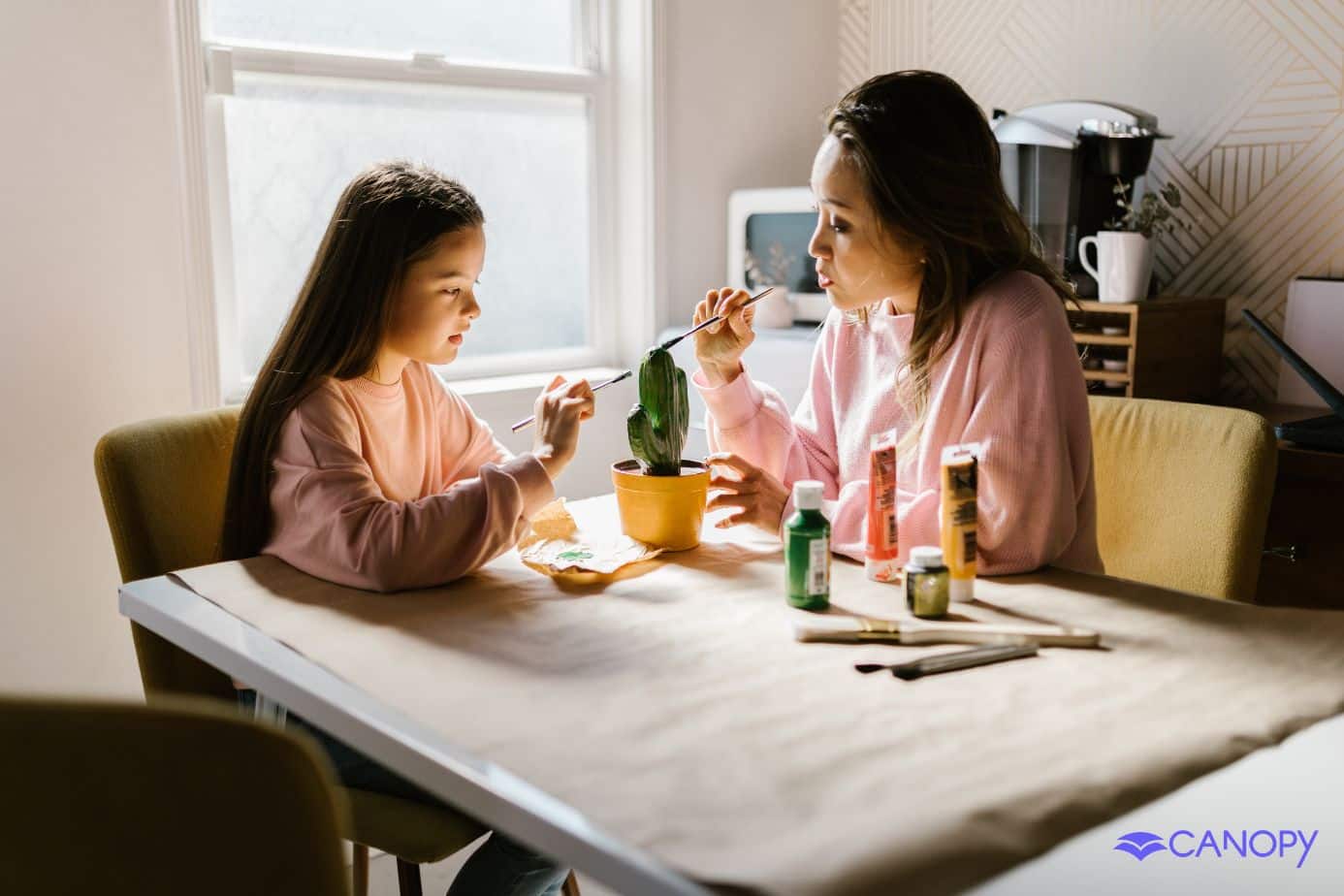Looking for ways to start a screen detox for kids—especially toddlers? You’re not alone.
According to a recent Pew Research study, 71% of parents with young children are at least somewhat concerned that their kids may be spending too much time in front of screens.
And those concerns are valid. While screens can be educational and entertaining in moderation, too much screen time—especially for toddlers—can lead to serious side effects like:
Poor sleep
Shortened attention spans
Stunted physical, emotional, and social development
Increased risk of depression and anxiety
That’s why many parents are now looking for screen time detox strategies that work without completely banning technology. In this guide, we’ll explore 8 science-backed ways to detox your child from screen time — especially if you’re wondering how to detox your toddler from TV without meltdowns or guilt.
You can skip ahead to the first screen detox strategy, or keep reading to learn more about the dangers of excessive screen time and what experts actually recommend.
The Scary Side Effects of Too Much Screen Time (And What Experts Say)
Excessive screen time can have a direct impact on your child’s cognitive, emotional, and social development.
For instance, one recent study showed that toddlers with high screen exposure engaged in fewer parent-child conversations, produced fewer sounds, and had fewer back-and-forth interactions—key elements for language acquisition and emotional growth.
In other words: without moderation, TV time can delay critical development milestones.
And that’s not all.
Inattention: Children exposed to more than 2 hours of screen time per day are up to 6 times more likely to suffer from attention problems than those with less than 30 minutes of daily exposure.
Obesity risk: Toddlers who watch excessive TV at age 2 are significantly more likely to be overweight or obese by age 4.5, according to longitudinal research (source).
That’s why so many parents are turning to screen detox for toddlers — not as punishment, but as a way to hit “reset” and promote healthier routines.
Screen Time Guidelines for Toddlers by Experts
The American Academy of Pediatrics recommends that for kids under the age of 18 months, we should minimize or eliminate screen time, other than video chats.
For preschool-age kids, they say that screen time limits are vital. Their partner organization, the American Academy of Child & Adolescent Psychiatry, recommends the following:
- Between 18 and 24 months, screen time should be limited to watching educational content with a caregiver.
- Between 2 and 5 years, non-educational screentime should be limited to 1 hour a day on weekdays and 3 hours a day on weekends.
The World Health Organization is even firmer. They recommend:
- No screen time at all for kids younger than 2 years old.
- No more than an hour for kids between 2 and 5 years old, with less time preferred.
While all this may sound scary, there is hope.
As we learn about the detrimental effects of excessive screen time on our toddlers, we also learn how best to move forward.
Screen Time Detox for Toddlers: 8 Science-Backed Strategies
In our digital world, eliminating screen time completely isn’t always realistic — and that’s okay.
The goal of a screen detox for kids isn’t to throw the TV out the window. It’s to create structure, restore balance, and use screens more intentionally.
That’s why we’ve gathered 8 expert-backed strategies to help you:
Understand how to detox your toddler from TV without drama
Build healthier screen habits as a family
Navigate digital media in a developmentally appropriate way
Each of these strategies is simple to implement and grounded in research. Whether you’re starting a full-screen detox toddler plan or just want to reduce screen time gradually, these tips will help you move forward with confidence.
These strategies are all backed by science and are also easy to put into action.
Strategy #1. Replace Screen Time with Physical Activity
According to the American Academy of Pediatrics (AAP), toddlers should get at least 60 minutes of unstructured physical activity each day.
This is an essential part of any screen detox for kids—because physical activity not only supports healthy development but also naturally reduces reliance on screens. These activities should be child-led but include adult participation to help toddlers stay engaged and moving.
Research shows that just 60 minutes of active play three days a week supports social maturity and motor skills. Even more compelling, limited screen time is linked to better executive function — the mental abilities that help children plan, pay attention, and manage tasks. In short, a proper screen detox toddler plan is great for both body and brain.
And your role matters. Studies show that physical activity is even more effective for toddlers when caregivers are involved. Shared playtime can help them better regulate emotions and build social skills, which is especially helpful when trying to detox a child from screen time.
Here are some screen-free activities to include in your TV detox for toddlers:
Play active games like Ring-A-Ring O’Roses or tag.
Pretend to be animals – slither like a snake, hop like a frog, or crawl like a bear.
Try toddler yoga – YouTube has many great videos for beginner routines.
Have a dance party with your child’s favorite playlist.
Chase bubbles – a timeless, giggle-inducing activity.
Create an obstacle course – use furniture or even yourself as part of the fun.
If you’re looking for more help managing your child’s screen exposure, our guide on how to block YouTube on iPhone and iPad and how to block YouTube on tablets can help reduce passive viewing and encourage more active play.
Strategy #2. Schedule Screen and Internet Free Times
One of the most effective screen time detox for toddlers strategies is simply creating consistent screen-free zones or time blocks.
A 2022 review of six different studies found that parental interventions—like implementing a “TV off” rule during certain hours or replacing screen time with alternative hands-on activities—can significantly reduce screen usage.
This is a smart way to detox a toddler from TV. By scheduling screen-free periods, you encourage your child to build healthy habits and engage in more meaningful activities.
You don’t have to adopt a rigid screen schedule. Instead, ask yourself:
Do you want a screen-free morning routine?
Should dinner time be screen-free for deeper connection?
Would a digital wind-down routine before bed work better for your family?
Your home, your rules — and your routines should reflect what works best for your unique lifestyle.
To help with this, consider using a parental control app like Canopy. Our app makes it easy to set custom time-based limits, allowing you to block internet access during meals, bedtime, or playtime. It’s a great way to gently enforce boundaries and support a successful screen time detox.

You can fully customize when you want these screen downtimes to kick in and for how long. You can also create daily or weekly screen downtime rules that repeat, ensuring a predictable and consistent routine.
Strategy #3. Practice Social and Emotional Learning
Do you wish someone had taught you the important skills of how to identify feelings, navigate interpersonal relationships, and make responsible decisions when you were a kid?
Well, that’s exactly what social and emotional learning (SEL) is.
Experts are understanding just how important it is that children learn these vital skills. Studies show that SEL has positive effects on the success of children, both academically and in life in general.
So important is this type of learning that it is now being incorporated into school curriculums.
So what can we do to foster this kind of learning at home? And what does it have to do with screen time?
First up, as this study shows, our homes are our first classrooms when it comes to social-emotional learning.
Because excessive screen usage is linked to problems in SEL, putting restrictions in place at home can be a first step in helping kids interact socially and manage difficult emotions.
Time away from the screen can also help you explore other activities that help with SEL.
Activities to Promote Socio-Emotional Learning
The National Association for the Education of Young Children (NAEYC) offers these suggestions to promote SEL:
- Use puppets: Puppets help you to introduce children to big feelings like happy, sad and angry and can be a great way for them to express their feelings. Puppets may even help you have a conversation about why you’re taking a screen away.
- Think out loud: Solve your problems verbally. “Oops! I dropped the cup on the floor. That means I’ll have to pick it up so nobody trips.”
- Read stories: Stories are the perfect inroad for discussing feelings. Talk about what the characters are feeling and what they might do in the situation.
- Do chores together: Sweeping, folding laundry, and setting the table just got a whole lot more fun!
- Play games: Play is the first place we learn to cooperate with others, wait our turn, and handle frustration.
And here are some more unconventional activities:
Let your toddler paint faces and emotions on smooth pebbles. This activity helps them express and recognize different emotions through art. You can then use these pebbles to create stories, teaching empathy and understanding.
Make masks with different facial expressions using paper plates and craft supplies. Use these masks to discuss and act out various emotions, helping toddlers identify and understand their own feelings.
Create a “mindfulness jar” with glitter and water. When shaken, the glitter swirls around and then slowly settles, teaching toddlers about calming down and mindfulness.
Use a mirror to make different facial expressions and have your toddler mimic them. Discuss what each expression means and when they might feel that way, helping them recognize and express emotions.
Pretend to be different animals and act out their behaviors and emotions. Discuss how animals might feel and why, linking animal behavior to human emotions and social interactions.
Strategy #4. Block Non-Child Directed Programs From Your Devices
This study of over 15,000 kindergarteners between the ages of 3 and 6 revealed two very important findings:
- Screen exposure is consistently associated with mental health issues.
- The type of content kids see on screen matters.
When children are viewing content that is not meant for them, they are so much more at risk for developing mental health issues.
There are two primary ways you can help ensure that they get content that is beneficial for them rather than content that is going to do harm:
Step 1: Find age-appropriate content
Find age-appropriate educational content, like YouTube videos aimed at toddlers. Choose them together purposefully. For example, decide to watch a particular program or play one round of an interactive game together.
Research on child development reveals that educational programs that are well-designed and age-appropriate can help children learn social skills and foster empathy, tolerance, and respect.
In special situations, like during a medical procedure, toddlers can also be calmed by the right kind of screen usage.
But in order to reap the benefits, it’s vital that the screen time be intentional.
Step 2: Block all non-child directed programs
Here, our parental app, Canopy can help. You can:
Block websites that could be harmful. No matter how hard you try, little fingers can be very good at opening up things they shouldn’t. Canopy can prevent this with a simple setting switch.
Filter out adult content that can be damaging. If you don’t want to block an website completely but do want to limit its contents, Canopy can help you with that, too.
Canopy uses AI to scan and understand harmful and inappropriate content in real-time, and filters it out before it even reaches your child’s device.
You can choose whether you can choose whether a website is:
- Allowed
- Blocked
- Filtered to prevent harmful content
Strategy #5. Remove Screens from Children’s Bedrooms
Bedrooms should be a device-free zone for kids — especially if you’re in the process of a screen detox for kids or trying to detox your child from screen time.
Getting a good night’s sleep is vital at any age, and especially important when you’re growing and developing at the rate of a toddler.
Unfortunately, screen time before bed can have disastrous effects on your child’s sleep patterns.
Screens emit blue light, which interferes with melatonin production—the hormone that helps us sleep. By removing screens from bedrooms, you’re not only supporting your toddler’s sleep, but also promoting healthier habits as part of their screen time detox.
If you’re wondering how to detox a toddler from TV, this is a powerful place to start. Instead of relying on screens, try replacing them with calming bedtime activities like:
Encourage bedtime stories or let your child pick out books to read before bed. This promotes literacy and provides a calming bedtime routine.
Offer puzzles or board games that can be played before bedtime. These activities stimulate the mind and provide quality family bonding time.
Provide art supplies like crayons, coloring books, or building blocks for creative play. This encourages imagination and fine motor skills development.
Introduce activities like drawing, coloring, or doing simple crafts. These can be soothing and help your child wind down before sleep.
Play soft, calming music or audiobooks at bedtime. This can help create a relaxing atmosphere and promote better sleep.
Strategy #6. Engage in Sensory Activities
We experience the world through our senses — sight, hearing, smell, touch, and taste.
To get your toddler away from the screen, opt for sensory play — basically, activities that engage their senses. Not only will this kind of activity decrease the negative impacts of too much screen time, but it will also help them develop vital skills.
We have two sensory systems in our bodies:
- Our proprioception sense helps us know how our body parts fit together and how much pressure is needed to do activities like push, pull, hold, or lift objects.
- Our vestibular sense allows us to maintain balance while doing activities.
Sensory play helps to develop these systems. As a result, it can help with:
- Language skills
- Motor skills
- Brain development
- Social interaction
- Curiosity and the desire to experiment
It’s no wonder then that sensory play has proven to be an effective strategy in early childhood education.
Sensory play activities are broad in scope. Here are some of them:`
10 Sensory Activities for Toddlers
- Sensory Bins: Fill a bin with various materials like rice, beans, pasta, or sand. Add scoops, cups, and small toys for your toddler to explore. This activity stimulates tactile senses and encourages fine motor skills.
- Water Play: Set up a water table with cups, funnels, and sponges. Toddlers love pouring and splashing water, which helps develop hand-eye coordination and sensory exploration.
- Bubble Wrap Stomp: Lay out bubble wrap on the floor and let your toddler stomp on it. The popping sounds and the texture underfoot offer a fun sensory experience.
- Painting with Ice Cubes: Freeze water mixed with food coloring in ice cube trays with popsicle sticks as handles. Let your toddler paint with the melting ice cubes on paper. This activity combines art and sensory play.
- Texture Walk: Create a path with different textures like carpet squares, bubble wrap, foam mats, and sandpaper. Let your toddler walk barefoot over the path to experience various tactile sensations.
- Shaving Cream Play: Spread shaving cream on a tray and let your toddler squish, smear, and draw in it. Adding drops of food coloring can make it even more fun. This activity is great for tactile exploration and creativity.
- Nature Sensory Bags: Fill sealable plastic bags with items from nature like leaves, flowers, small sticks, and pebbles. Toddlers can squish and manipulate the bags, exploring the textures and visual elements safely.
- Cornmeal or Flour Play: Spread cornmeal or flour on a baking tray and let your toddler draw, scoop, and play. Adding small toys or cars can make it even more engaging.
- Gelatin Sensory Play: Prepare gelatin and let it set with small toys or objects inside. Toddlers can dig and squish the gelatin to find the hidden items, enjoying the squishy texture.
- Sensory Bottles: Fill clear plastic bottles with different materials like glitter, beads, water, and food coloring. Seal them tightly and let your toddler shake and observe the contents. These bottles are great for visual and auditory stimulation.
Strategy #7. Get Your Kids Into the Let Grow Movement
For toddlers, unstructured (supervised!) play helps them discover the world they’re living in. There’s so much worth in picking up that interesting-looking stone or deciding what game to play.
The Let Grow Movement has recognized the importance of letting kids play outside and interact with the world around them.
One of their key strategies is Independence Therapy — essentially, as they put it, “treating anxious kids with a “mega dose” of independence.”
Get them to run errands, walk to school, and interact with a world that is maybe not as scary as they have come to believe.
The first pilot project showed very promising results, working better than medication and Cognitive Behavioral Therapy.
Of course, you’re not going to get your toddler to run errands quite yet. But getting involved with the movement early on in your child’s life will impact them down the line.
Let Grow offers a combination of free resources (like this list of phone-free camps for older kids), and programs designed for kids 5+. Their programs include play clubs, the Think for Yourself essay contest, and the Let It Grow project which offers the simple assignment of “Go home and do something NEW on your own.”
Strategy #8. Read Stolen Focus by Johann Hari
The reality is, it’s not just our toddlers who may be in need of a screen time detox. We live in a culture where paying attention is becoming more and more impossible.
Johann Hari argues that, rather than blame ourselves, we should recognize that we live in a culture that has “stolen our focus”.
But rather than this being a cause to feel completely hopeless, Hari argues that recognizing it can be the first step in getting our focus back — and that control over our devices is crucial in this quest.
Actively working to rediscover our attention can have enormous implications for parenting. We know, for example, that screen usage at a young age is linked to a greater risk of developing ADHD symptoms.
Putting restrictions in place so that we are in control of our devices, rather than them being in control of us, should start as young as possible. There’s so much that is trying to grab the attention of our toddlers. We should have a say in what is allowed to.
FAQs
A screen detox for kids refers to a short or extended break from digital devices — TVs, tablets, smartphones, and computers. It helps reset children’s habits, reduce dependence on screens, and encourage healthier activities like play, reading, or outdoor time.
To begin a TV detox for toddlers, start by removing passive TV time from daily routines. Replace it with engaging alternatives like puzzles, play-dough, music, or outdoor exploration. Keep routines predictable, and limit background TV exposure as well.
The length depends on your child’s screen usage. For younger children, even a 3-day screen time detox can reset habits. For older kids, a 7-day break (with gradual reintroduction) can be more effective.
Look out for mood swings, irritability when the screen is turned off, lack of interest in non-screen activities, sleep disturbances, or obsession with specific shows or games. These are red flags that it may be time to detox your child from screen time.
For a smoother screen detox toddler transition:
Explain the change clearly and positively.
Offer fun replacements (e.g. sensory play, crafts).
Be consistent with screen-free times.
Join in the alternative activities to make them feel exciting.
Yes. Reducing screen exposure often leads to better sleep, improved focus, more physical activity, and increased interest in imaginative play. A screen time detox for toddlers can also support emotional regulation.
There’s no wrong time. Screen detox for kids is especially important between ages 1–7, when habits and brain development are most sensitive to media exposure.





![8 Best Screen Time Apps for Adults & Families [Tested By Us]](https://canopy.us/wp-content/uploads/2024/05/best-screen-time-apps.png)